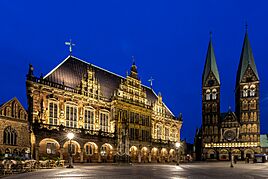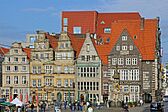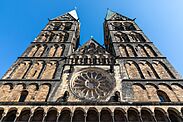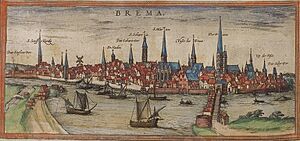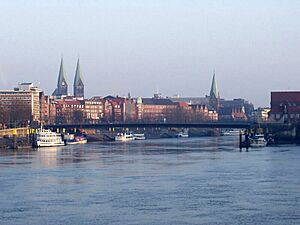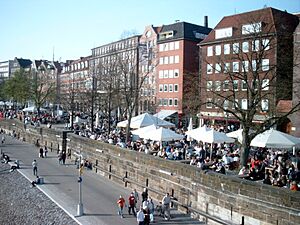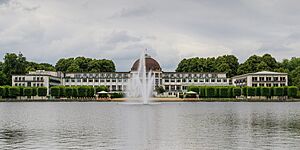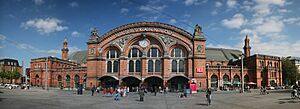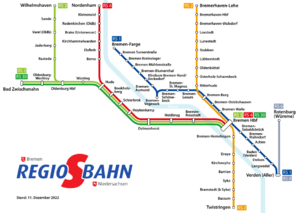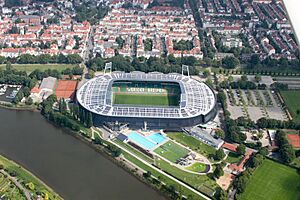Bremen facts for kids
Quick facts for kids
Bremen
Breem / Bräm (Low German)
|
|||
|---|---|---|---|
|
City Hall and Cathedral
Bremer Marktplatz
Schütting
Schnoor
Bremen Cathedral
|
|||
|
|||
| Country | Germany | ||
| State | Bremen | ||
| Subdivisions | 5 boroughs, 19 districts, 88 subdistricts | ||
| Area | |||
| • City | 326.73 km2 (126.15 sq mi) | ||
| • Metro | 11,627 km2 (4,489 sq mi) | ||
| Elevation | 12 m (39 ft) | ||
| Population
(2022-12-31)
|
|||
| • City | 569,396 | ||
| • Density | 1,742.711/km2 (4,513.60/sq mi) | ||
| • Metro | 2,800,000 | ||
| Demonym(s) | Bremer (m), Bremerin (f) | ||
| Time zone | UTC+01:00 (CET) | ||
| • Summer (DST) | UTC+02:00 (CEST) | ||
| Postal codes |
28001–28779
|
||
| Dialling codes | 0421 | ||
| Vehicle registration | HB (with 1 to 2 letters and 1 to 4 digits) | ||
| Website | Bremen online | ||
Bremen is a famous city in Germany. It is the capital of the Free Hanseatic City of Bremen. This state is unique because it's made up of two cities: Bremen and Bremerhaven.
Bremen is home to about 577,000 people. This makes it the 11th largest city in Germany. It's also the second-largest city in Northern Germany, after Hamburg.
The city sits on the River Weser, which is the longest river completely in Germany. Bremen is about 60 kilometers (37 miles) from where the river meets the North Sea. The city is surrounded by the state of Lower Saxony.
Bremen is a big center for culture and business in Northern Germany. You can find many historical galleries and museums here. The Bremen City Hall and the Bremen Roland statue are so important that they are a UNESCO World Heritage Site. Bremen is also famous for the Brothers Grimm's fairy tale "Town Musicians of Bremen". You can even see a statue of these musicians in front of the city hall!
Bremen has a busy port, which is the second-largest in Germany. The Bremen Airport is also one of Germany's busiest. Many international companies have their homes here, like Hachez chocolate. The football club SV Werder Bremen plays in the Weserstadion by the river.
Contents
Bremen's Past
For over 1,200 years, Bremen has had a rich history. For a long time, it was an independent city. It was part of the Hanseatic League, a group of trading cities that controlled trade in the North Sea and Baltic Sea.
Bremen fought to stay independent. After the Thirty Years' War, it had to deal with the Swedish Empire. Later, in 1720, it was recognized as a free city. However, it was taken over by France in 1810 but became independent again in 1815.
In 1871, Bremen joined the German Empire. Its port became very important for people moving from Germany to the Americas. It was also a key place for Germany's trade with its colonies.
After World War I, Bremen lost some of its freedom under the Hitler regime. During World War II, much of the city was destroyed. But after the war, Bremen regained its independence. It became one of the founding states of West Germany.
Where is Bremen?
Bremen is located on both sides of the River Weser. It's about 60 kilometers (37 miles) upstream from where the river flows into the North Sea. The city's area is about 38 kilometers (24 miles) long and 16 kilometers (10 miles) wide.
Bremen is the second-largest city in northwest Germany by population. It is the eleventh largest city in all of Germany.
Bremen's Highest Points
The center of Bremen is built on a sand dune. The highest natural point in the city is 32.5 meters (107 feet) above sea level. This is in Friedehorst Park. Because of this, Bremen has the lowest highest point of all the German states.
Bremen's Weather
Bremen has a moderate oceanic climate. This means it has mild winters and cool summers. This is because it's close to the North Sea. Extreme temperatures are rare. It rarely gets colder than -15°C (5°F) or hotter than 35°C (95°F).
Rainfall is spread out evenly throughout the year. Snowfall can vary a lot each winter. Winters can be quite cloudy, but there has been more sunshine in recent years.
People in Bremen
| Historical population | ||
|---|---|---|
| Year | Pop. | ±% |
| 1350 | 10,000 | — |
| 1650 | 25,000 | +150.0% |
| 1811 | 36,630 | +46.5% |
| 1852 | 57,055 | +55.8% |
| 1864 | 70,692 | +23.9% |
| 1871 | 82,969 | +17.4% |
| 1890 | 125,684 | +51.5% |
| 1900 | 161,184 | +28.2% |
| 1910 | 247,437 | +53.5% |
| 1919 | — | |
| 1925 | 295,585 | — |
| 1933 | 324,189 | +9.7% |
| 1939 | 431,800 | +33.2% |
| 1945 | 366,427 | −15.1% |
| 1951 | 463,049 | +26.4% |
| 1961 | 569,862 | +23.1% |
| 1971 | 594,591 | +4.3% |
| 1981 | 553,261 | −7.0% |
| 1991 | 551,219 | −0.4% |
| 2001 | 540,950 | −1.9% |
| 2011 | 542,707 | +0.3% |
| 2022 | 575,071 | +6.0% |
| Population size may be affected by changes in administrative divisions. | ||
Bremen's economy grew a lot in the 1950s and 60s. This brought many people to the city, especially from Turkey and southern Europe. More recently, people have moved to Bremen from countries like Poland and Bulgaria. After 2015, refugees from Syria and other places also settled here.
Today, Bremen has a population of about 567,000 people. It is the 11th largest city in Germany. Many people living in Bremen have roots from other countries, making it a diverse city.
Here are some of the nationalities living in Bremen as of December 31, 2024:
| Rank | Nationality | Population (2024) |
|---|---|---|
| 1 | 23,765 | |
| 2 | 18,805 | |
| 3 | 12,905 | |
| 4 | 9,290 | |
| 5 | 8,925 | |
| 6 | 5,410 | |
| 7 | 4,385 | |
| 8 | 4,120 | |
| 9 | 3,965 | |
| 10 | 3,940 | |
| 11 | 2,820 | |
| 12 | 2,750 | |
| 13 | 2,430 | |
| 14 | 2,375 | |
| 15 | 2,285 |
How Bremen is Governed
Bremen has a city assembly called the Stadtbürgerschaft. This group makes decisions for the city. The people of Bremen vote for their representatives every four years.
Bremen is known for its left-leaning politics. This is partly because of its history with many workers in ports and shipyards. The Social Democratic Party of Germany (SPD) has often been in charge. Currently, the city is run by a group of parties: the Social Democratic Party, Alliance 90/The Greens, and The Left.
One of the two mayors is chosen to be the President of the Senate. This person leads both the city and the state. The current mayor is Andreas Bovenschulte.
Bremen is divided into 5 main areas called boroughs. These boroughs are further split into smaller districts and subdistricts.
Fun Places to See in Bremen
- Many interesting places are in the Altstadt (Old Town). This area is shaped like an oval, with the Weser River on one side.
- The Market Square is a main attraction. It has the beautiful Town Hall of Bremen. This building was built in the 1400s and later got a fancy Renaissance style front. It's a UNESCO World Heritage Site.
- Next to the Town Hall, you'll see the Bremen Roland statue. This statue from 1404 shows Roland, a protector of the city. There's also a bronze statue of the Town Musicians of Bremen from the famous fairy tale.
- Other cool buildings around the Market Square include the Schütting, an old guild hall, and the Stadtwaage, a former weigh house.
- St Peter's Cathedral is east of the Market Square. It's a large church from the 13th century.
- The Liebfrauenkirche (Our Lady's Church) is the oldest church in Bremen, built in the 11th century.
- The Böttcherstraße is a unique street near the river. It was changed in the 1920s by a coffee businessman. It has a mix of old Gothic and newer Art Nouveau styles. You can see the Glockenspiel House with its special bells here.
- The Schnoor is a small, charming area with narrow lanes and old houses from the 1600s and 1700s. Today, it has cafes and art shops.
- The Schlachte was Bremen's medieval harbor. Now, it's a lively riverside area with pubs and bars.
- The Viertel district has many 19th-century houses, museums, and theaters.
- Knoops Park is a large green space where locals enjoy visiting. You can even rent small rowboats there.
- The Nasir Moschee is the first mosque built specifically for the Ahmadiyya Muslim Community in Bremen.
Other fun places to visit:
- Universum Science Center: A modern museum where you can learn about science.
- Rhododendron-Park Bremen: A large park with many beautiful rhododendrons and azaleas. It also has a botanical garden.
- Botanika: A nature museum inside the Rhododendron-Park, focusing on biology.
- Beck's Brewery: You can take tours and even taste beer here.
- Kunsthalle Bremen: An art museum with paintings from the 19th and 20th centuries.
- Focke Museum: A museum about art and cultural history.
- Übersee Museum Bremen: This "Overseas Museum" is about natural history and different cultures. It's near the main train station.
- Weserburg Museum für moderne Kunst: A modern art museum located on an island in the Weser River.
Interesting Buildings
- Mediumwave transmitter Bremen
- Fallturm Bremen: A special tower used for experiments in weightlessness.
- Bremen-Walle Telecommunication Tower
Bremen is also home to Germany's first school built to the "Passivhaus" standard. This means it uses very little energy for heating and cooling.
Bremen's Economy
Bremen has a strong economy. In 2013, its economy per person was higher than the average for Germany.
Bremen is an important center for the Airbus company. They build parts for large Airbus planes here, like wing sections and landing flaps. The Airbus A400M military transport aircraft also has parts assembled here. Over 3,100 people work at Airbus Bremen.
Other big companies in Bremen include EADS Astrium and OHB-System, which are major space companies in Europe. There's also a Mercedes-Benz factory that builds several car models.
Beck & Co makes famous beers like Beck's and St Pauli Girl in Bremen. Many food companies also have their main offices here, such as Kellogg's, Kraft Foods (known for Jacobs Coffee and Milka Chocolate), and Hachez chocolate.
Getting Around Bremen
Bremen has an international airport just 3 kilometers (2 miles) south of the city center.
You can travel around Bremen using trams and buses. These services are run by the Bremer Straßenbahn AG (BSAG).
The Bremen S-Bahn is a train network that connects Bremen with nearby cities. It goes from Bremerhaven in the north to Twistringen in the south. It also connects to Oldenburg in the west. This network helps people travel easily across the region.
Exciting Events in Bremen
- On August 8, 1992, Michael Jackson performed a show at the Weserstadion as part of his Dangerous World Tour. He also started his HIStory World Tour in Bremen later.
- Every year in the last two weeks of October, Bremen hosts the Freimarkt. This is one of Germany's oldest and biggest fairground festivals.
- Bremen is home to the "Bremer 6 Tage Rennen," a bicycle race held at the Bremen Arena.
- Young musicians from all over the world come to Bremen each year for the International Youth Symphony Orchestra of Bremen (IYSOB).
- Bremen hosted the RoboCup competition in 2006, where robots compete in sports.
- In 2009, Bremen hosted the 50th International Mathematical Olympiad (IMO), a competition for talented math students.
- The famous band The Rolling Stones named a live album "Bridges to Bremen," which was recorded in the city in 1998.
Sports in Bremen
Bremen is well-known for its football team, Werder Bremen. They have won the German Football Championship four times and the German Football Cup six times. Their home stadium is the Weserstadion. This stadium is special because it's almost completely covered in solar cells, making it a big source of renewable energy.
Learning in Bremen
Bremen has several important places for education:
- The University of Bremen is the largest university in the city, with 18,000 students. It also has the international Goethe-Institut.
- There is a University of the Arts and the Bremen University of Applied Sciences.
- In 2001, the private Jacobs University Bremen was founded.
- Many German research groups have centers in Bremen, especially focusing on ocean sciences. These include the Max Planck Institute for Marine Microbiology and the Center for Tropical Marine Ecology.
- The Fraunhofer Society has centers in Bremen for material research and medical imaging.
Other Interesting Facts
- Bremen is connected to the famous fairy tale by the Brothers Grimm, "Town Musicians of Bremen". Even though the animals never actually reach Bremen in the story, the city celebrates them!
- The 1922 film Nosferatu, eine Symphonie des Grauens was mostly set in Bremen.
- In July 2022, the music group Yorushika released a song titled Bremen.
Famous People from Bremen
Partner Cities
Bremen is connected with these cities around the world:
See also
 In Spanish: Bremen para niños
In Spanish: Bremen para niños
- List of mayors of Bremen


